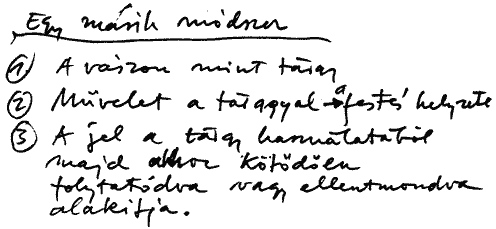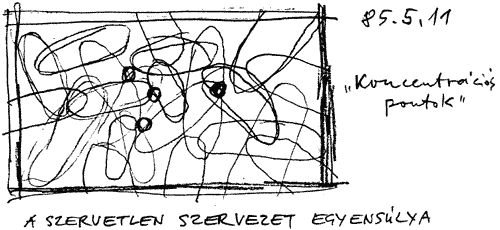On Art 1968-91 |
Painting I. 1966-70 |
How It All Started 1968-71 |
Signs [Modules] 1971-79
Conceptual works 1973-82 |
The Ego Problem 1973-76 |
Objectworks 1974-93
Painting II. 1984-89 |
Sound Sculptures 1974-91 |
Performance 1972-92
Technical Images 1974-92 |
Space Works 1970-93 |
Network/Institutions 1970-93
1984 Plánum 84 (for the Festival of Minimal Music)
1985 Pictures with neon lamps
1987 New Paintings Series
1989 The Berlin Series
March, 1987
1. The emphasis is on the action, that's what makes the picture into an object.
2. All objects and materials are the result of some action.
3. All materials have properties. These properties converge.
4. Then comes imagination, and you have the “image-inary image”, [the picture].
5. Since everything around me is vulgar, I refuse to paint in any but a vulgar manner. Otherwise it won't be real.
March 14, 1987
Method of painting
1. I always treat the canvas according to my frame of mind at the moment.
2. All at once it wants to turn into something.
3. Then it starts to talk to me, and I answer by continuing.
4. Given the proper answer, the painting is done.

April, 1987
What the canvas wants.
What paint can do.
What I think.

April 5, 1987
The painting is the model of the close relationship between internal and external light.
The painting is objectified experience. Its point is to reflect the entire range of human existence
(sensual and intellectual). It narrows this task down to an optimal minimum, particularly within a given subject, but insists on intimating the presence of the whole.
April 13, 1987.
Paint is both color and material.
Paint, in itself, is spiritual and material.
Color goes with light, because they are both spiritual.
Color can be projected; material cannot, only its illusion.
With all possible means, in the simplest possible way.
The proper use of technique presupposes knowledge; consequently, what is communicated overshadows the technique.
notes, plans [13.04.87.]
April 16, 1987
We must learn to alienate ourselves from all forms and colors that we like, so that, in the process of creation, we may learn to like other things that are possible.
A project is only one of all possible projects. What comes next is an open question: subsequent events are the result of influences, it is the decisions of the moment that make them specific. Like in history.
notes, plans [18.04.87] [22.04.87] [Modern Petőfi]
A work of art might be grave, onerous or depressing, yet it must be light as the lightness we feel when in the midst of all our problems, the thought strikes us that we're alive.
The feeling of alienation, too, is only a feeling. There's no feeling on which imagination cannot build.
The creation of every work of art has a history. Action comes from experience, and creates experience. All good ideas are also beautiful. Alienation comes from understanding and mastering a situation, and is rooted in the desire to go on.
The prime characteristic of my painting is its object-orientation. Object-orientation means the generation, between objects, of a relationship which does not exist in reality, but which is congruent with how things are.
Another important thing is the means of articulation, which must also suggest naturalness: dripping, blowing, the presence of materials in all their plasticity.
Nearness and distance stand for another set of opposites: conceivable and inconceivable. Things are not unequivocal, only our decisions make them so.
I've given up making plans. Everything depends on the moment, on the situation. Everything is very uncertain. Nothing is known ahead of time. There's no way to calculate the future. One has to be right in the midst of it all, and the good decisions are those suggested by the moment.
May 11, 1987
“Points of Concentration”
A chaotic collection of footprints of different sizes painted in different ways, which nevertheless possess a certain coherence: BEING AS IMPROVISATION.

On Art 1968-91 |
Painting I. 1966-70 |
How It All Started 1968-71 |
Signs [Modules] 1971-79
Conceptual works 1973-82 |
The Ego Problem 1973-76 |
Objectworks 1974-93
Painting II. 1984-89 |
Sound Sculptures 1974-91 |
Performance 1972-92
Technical Images 1974-92 |
Space Works 1970-93 |
Network/Institutions 1970-93